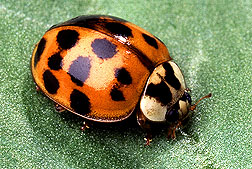Science Update
|
|
Two New Peas for the Southeast
For the freezer, gardeners and the food industry have two new high-yielding pinkeye-type southern peas. ARS scientists bred Charleston Greenpack for the industry and Petite-N-Green for the back yard. Dried peas of both varieties have the green color of fresh peas. Both are adapted to the Southeast and can be harvested for the fresh market or for processing. Their yields are comparable to leading pinkeye-type cultivars. Charleston Greenpack seed is already being marketed to commercial growers. Petite-N-Green should be available to home gardeners by spring of 2000. ARS scientists developed the new peas under a cooperative research and development agreement with Western Seed Multiplication, Inc., of Oglethorpe, Georgia. In company farm trials in Georgia and Florida, Charleston Greenpack performed well overall and showed excellent resistance to blackeye cowpea mosaic virus. Western Seed has an exclusive license to market this pea variety.
Richard L. Fery, USDA-ARS U.S. Vegetable Laboratory, Charleston, South Carolina; phone (843) 556-0840.
Feeling Ladybugged?
A new indoor trap invented by ARS scientists uses a blacklight to harmlessly capture beneficial—but sometimes annoying—ladybugs. From spring to early fall, the Asian multicolored lady beetle, Harmonia axyridis, helps farmers by gobbling pests such as aphids, greenbugs, and other insects that damage crops. But in autumn, the beetles seek refuge. Sometimes large numbers pick a home or other building for their "winter camp." Homeowners are understandably annoyed. The insects are harmless, but if disturbed or squashed, they can emit a foul odor and secrete a yellow substance that stains surfaces and fabrics. The new trap uses no insecticide and can be assembled in minutes. Lady beetles and other flying insects attracted by the blacklight are quickly caught in a bag with a nonstick surface. Later, they can be released outdoors. In indoor tests, the trap captured nearly 100 percent of the ladybugs. ARS is evaluating applications from companies interested in licensing the technology.
W. Louis Tedders (retired), USDA-ARS Southeastern Fruit and Tree Nut Research Laboratory, Byron, Georgia; phone (912) 956-6434.
Licensing contact: June Blalock, USDA-ARS Office of Technology Transfer, Beltsville, Maryland; phone (301) 504-5989, fax (301) 504-5060.
New Genetics Initiatives
Studies of agricultural genetics will get a multiple boost—from two new plant-gene centers in Missouri and New York and from eight new gene-analyzing machines at ARS labs. These initiatives will accelerate progress in mapping, isolating, identifying, and evaluating animal and microbial genes, as well as plant genes. Many benefits should accrue to our food supply, the farm sector, industry, and the environment.
ARS will operate the new Center for Bioinformatics and Comparative Genomics at Cornell University sites in Ithaca and Geneva, New York. The center will help researchers discover all the genes in grains—like corn, wheat, and rice—and plants in the family that includes tomatoes, potatoes, and peppers. ARS scientists and bioinformatics specialists and Cornell faculty will staff the center. Once gene structure is known, scientists can look for similar structures in gene databases of other organisms. Similar structure often connotes similar function. When function is identified, biotechnologists can try to rebuild a gene to make it more effective. Among potential benefits would be plants with improved disease resistance that require less chemical pesticide.
In Columbia, Missouri, ARS and university collaborators will set up a new maize genetics research center. Located in facilities at the University of Missouri, the center is being funded cooperatively by ARS and universities, with support from a 5-year, $11.1 million grant from the National Science Foundation. The scientists will have increased capacity to improve corn through biotechnology and computers. Other collaborators are located at Clemson University and the University of Georgia. By 2002, the scientists hope to develop a map containing information on essentially all of corn's genes. A maize DNA database will help researchers compare corn with sorghum, rice, and other grains.
The new DNA analyzer machines should begin arriving this spring at ARS labs in California, Florida, Georgia, Iowa, Maryland, Nebraska, New York, and Pennsylvania. The Perkin-Elmer ABI model 3700 DNA sequencers can decrease costs and boost a lab's productivity by an estimated 50 times, according to the manufacturer.
Judy St. John and Caird E. Rexroad, Jr., USDA-ARS National Program Staff, Beltsville Maryland; phone (301) 504-6252 [St. John], or (301) 504-7050 [Rexroad].
Edward H. Coe, Jr., USDA-ARS Plant Genetics Research Unit, Columbia, Missouri; phone (573) 882-2768.
"Science Update" was published in the April 1999 issue of Agricultural Research magazine.







